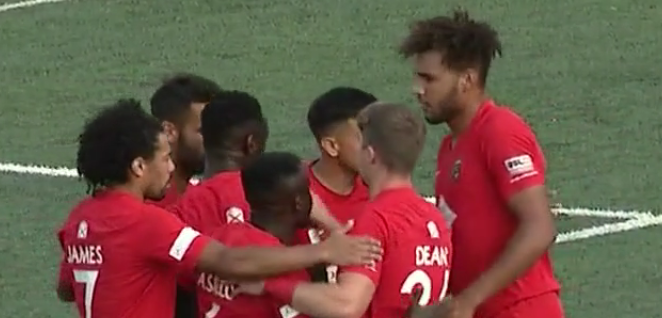This one was an exercise in proving statistics can sometimes make absolutely no sense.
After completely dominating the game for 8 minutes, getting the penalty that JJ Williams should have been awarded in the first game, also seeing the yellow card that Indy’s Karl Ouimette should have received for an near identical foul in said first game, and subsequently securing the lead through the inevitable Neco Brett goal, the Birmingham Legion proceeded to thumb their noses at Indy Eleven. They decided to them give them every opportunity to score.
Which they singularly failed to do. For one very good reason: the Three Sparks’ defense is stellar.
The Legion had about 55% of the possession in the first ten minutes or so of the game, but finished with just 35%. Which means that for the final 80 minutes they had just 32.5% possession. That sounds like a recipe for disaster, and usually would be, as strong teams like the Legion usually don’t have possession that low unless they are down a man or two. In this case, not so.
Indy simply struggled to shoot. Birmingham had racked up 5 shots before the Eleven attempted its first, a ludicrously wide attempt by Nicky Law. By the end of the first half, the Legion was still doubling up Indy with 10 shots to 5. With the good guys making just 2 shots on goal in the second half, Indy still outshot them only 14-12. In shots on target Birmingham led 6-3. And of the three Indy shots on target only one was any real challenge to Matt van Oekel. Indeed, Indy’s two best chances went wide (a long-range shot by Gordon Wild in the 64th minute and a header by Manuel Arteaga a couple of minutes later).
In xG, the Legion again had the better of it: 1.52 to 1.37. Per FotMob, the Eleven generated just 2 big chances in the entire game (the Legion had just 1, which would be the PK).
Clearly, the Three Sparks was simply not going to let Indy score. They did this in a couple of ways.
First, they denied penetration. Here’s the Indy heatmap:

They are playing left to right. The bulk of their possession is manifestly in their own half, and largely pushed wide left. They did get into the Legion 18. But take a look at the Birmingham heatmap:

Despite the fact that the Legion had barely a third of the possession, their field position is much more distributed. And the penetration into the Indy penalty area is in fact better. In other words, Indy was pushed back.
Let’s review this from another perspective. This is all the defensive actions (tackles, blocks, interceptions, clearances and recoveries) taken by the Legion back line plus Eli Crognale who replaced Ben Ofeimu:

There a good few inside the box, but the majority are scattered around the rest of the Birmingham half. Now, here’s the kicker. Add in one more player to this graphic:

Wit that one player defensive coverage almost doubles. It is of course Anderson Asiedu, who is the defensive anchor of the midfield 4. He was named Man of the Match and from this it is easy to see why. Anderson was a big part of keeping Indy backed up in their own half. In particular, he made 11 recoveries. Amazingly, he wasn’t fouled even once. Which was really bad tactics on Indy’s part, because that’s just about the only reliable way to dispossess him.
Birmingham has become very hard to score on. Matt van Oekel is tied for the lead in clean sheets with 5 (the others are Austin Bold’s Elliot Panicco and Tampa Bay’s Evan Louro). He’s also second in saves with 38 behind San Diego’s Trey Muse on 44. Overall, the Legion has allowed 8 goals in 11 games. Only Tampa Bay is conceding at a slower rate (they have allowed just 6 in 10 games). In contrast, Birmingham is just 25th in scoring, despite Neco Brett bagging goals at a rapid rate. The Three Sparks are riding their defense to victory, and never more so than in this game.






